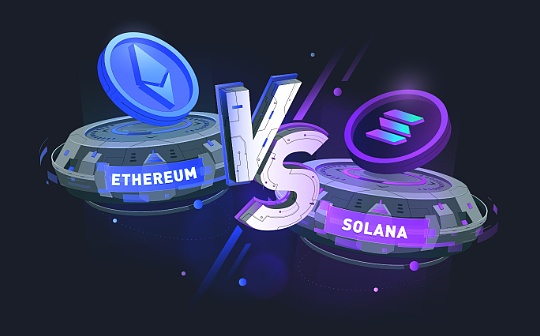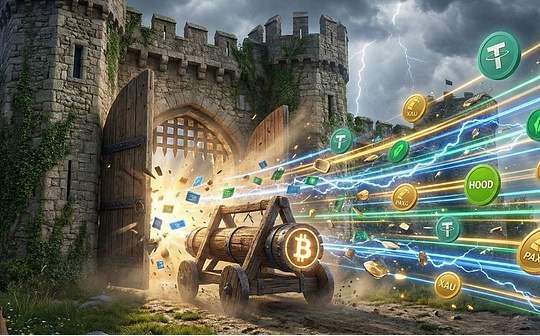
Author: Mert Source: X, @ryanberckmans Translation: Shan Oppa, Bitchain Vision
The only pillar network in the world will be Ethereum
Ethereum is the core pillar of the new global financial system composed of L2 and L1 applications.There is no other chain to match.
Mert puts forward the idea that Solana can transform into a core pillar, but Solana can never take on the role.Here are five reasons.
Four years ago, Ethereum decided to focus on becoming the backbone of the global financial system for L2 and L1 applications.Now this strategy is gradually considered to be the top L1 strategy, and it can even be said to be a clever decision. Although it is still in its early stages, signs have been revealed, such as the dominance of L2 and the scrambling of all parties to imitate.
Solana performed well in speculative and meme growth this quarter, as well as SOL price.However, I think Solana’s leadership has realized that L2 is expected to eat up other L1 market share and is trying to suggest that Solana can also transform into a pillar role similar to Ethereum.
But Solana is essentially not suitable as the pillar of L2, and even L1 applications worldwide are difficult to support.The reasons will be explained in detail below.
First, let’s see how Solana’s leadership gradually recognizes the strengths of Ethereum’s L2 core pillar strategy and tries to turn Solana in that direction.
Initially, Solana advocated the “single-chain” concept, claiming that its speed and low cost could attract global users to use a single Solana chain.This is their “monolithic” era, the “monolithic” architecture, which later became a burden (because in fact a single structure cannot meet global needs).Therefore, they turned their publicity focus to the term “integration”.
By the middle of this year, Solana admitted that L2 was in the right direction.Several factors contributed to this change.Solana’s leadership noticed that some flagship applications began to build custom L2 application chains on Sol, mainly because L2 can provide users’ favorite controls and customizations, while also being part of a larger system, without having to run consensus on their own.Earlier, a key Solana community member posted a hot post about Sol’s need to accept L2, which sparked a heated community response before Solana’s leadership formally acknowledged that L2 was inevitable.In addition, an important Sol development team has also turned to building SVM L2 on Ethereum rather than continuing to develop on Sol L1.These factors prompted Solana’s leadership to gradually lean towards L2.
(It should be noted that Solana did not directly acknowledge that Ethereum’s strategy on L2 has always been correct, but instead said that their L2 is not L2, but “Network Extensions”. This is a major marketing statement.Similar to Sol’s recently launched concept of “True TPS”. As Sol has included 80% consensus overhead on many information websites over the years, many websites still show that Sol has a TPS of 3000, but the real data is about 750 TPS. Solana invented the “True TPS” to correct this long-term misleading practice. Therefore, professionals who conduct serious due diligence need to be cautious about Solana’s claims—many cannot stand scrutiny.)
Coming this month, Solana leadership began discussing how to transform into a pillar strategy for Ethereum (but they couldn’t achieve that, as shown below).
So why is Solana now starting to support Ethereum’s pillar strategy?Why is this time?
The reason is that the global demand for a large number of new chains is emerging (thousands or even tens of thousands), and L2 is generally more advantageous than alternative L1.That’s why companies like Coinbase, Kraken, Sony, EVE Online, etc. chose L2, so becoming the backbone of L2 is a top strategy.
So can Solana simply transform into a pillar?Not because this strategy is not feasible for Solana (see the reason below for details).
In fact, Solana faces profound dilemmas in terms of technology and economic strategy.
What are the specific difficulties Solana faces?
-
Solana cannot meet even a fraction of the future global demand quickly or cheap enough.
-
Solana is not decentralized enough to attract real large capital.
-
Solana cannot serve as the global competitive pillar of L2.
-
Solana bundles consensus and execution together, which is slower and more expensive than just execution.This is why the most scalable L2 only needs to be executed without consensus, while benefiting from the trustless composability network effect across L2, it will be faster and cheaper than Solana in the future.See MegaETH.
This is crucial, not only is Solana not going to be the backbone, but it won’t even be the fastest or cheapest chain in the future.
Currently, for some people (including many investors), Solana may seem “everything is OK” – it seems to be an upgraded version of Ethereum.But this is far from the truth.Solana will be useless on the technical and economic levels soon.
Although ETH may have lost to BTC and SOL in terms of the season’s ratio (the season is not over yet), Ethereum is playing chess rather than simply taking one step.Ethereum is expected to win the “battle” of achieving global popularity on-chain applications, because it expands in a consistent way that the world actually operates – through an L1 pillar and L2 market.
In short, Ethereum is correct from beginning to end, and its strategy as a pillar is far superior to all L1 strategies.Although Solana’s leadership may suggest that they can be pillars, they cannot achieve it.
5 Reasons Solana Can Never Become a Global Pillars Network
1. Solana lacks true client diversity and is difficult to achieve in the short term.
Client diversity means that the blockchain is run by multiple independent programs simultaneously, effectively preventing attacks (through multiple independent development teams and programming languages) and accidents (multiple code bases can limit bugs to a single code base).Client diversity is a basic requirement for the global pillar network.
To achieve client diversity, you cannot rely on the rights and interests of most verifiers to run a single program.At least three independent chain clients are usually required, and balanced equity allocations are maintained between them.A protocol specification and upstream research community are also needed to ensure that all clients run towards the same clear goal.
Solana currently has only one production client (agave rust) and is trying to develop a second client (firedancer), but development is slow due to the lack of real protocol specifications and research community.The high optimization of the Agave rust client and the deep combination of the underlying hardware also make it more difficult to extract and re-implement protocol specifications.
Firedancer is not ready for a 50% interest in running the production environment.Even if it is successfully launched, Solana needs to develop a third production client and maintain a balance of interests between the three to achieve true client diversity.Each client must be a separate code base, with no code overlap, development team overlap, or code dependencies, and a different programming language.
Ethereum currently has four production clients that meet these standards and has been maintained for many years.
2. High bandwidth requirements
The Solana chain requires very high bandwidth (10Gbps upload is recommended), which significantly increases the difficulty and risk of decentralization.
The purpose of the global pillar network is to minimize risk, while high bandwidth requirements undoubtedly increase the burden.While high-capacity computers can be set up in specific locations, it is difficult to get 10Gbps upload speeds in many regions, especially without a corporate data center or VPN.
The global pillar must be able to operate almost anywhere.In the future, the demand for data centers can even be completely avoided, and the 10Gbps upload requirement makes it difficult for Solana to meet this requirement, and over time, Solana’s bandwidth problems will only become more serious.
3. The risk of suspension in the future is high
Solana has been out of service many times, but unlike Ethereum, it lacks a protocol-level fallback mechanism to continue generating blocks when it cannot “end”.
When the global pillar network supports hundreds of trillions of dollars in assets and is relied on by more than 200 countries around the world, it is crucial to ensure that the network does not shut down.
4. Lack of economic decentralization
Solana sold less than 2% of SOL tokens in the early stages, and the remaining nearly 98% were internally allocated.
In contrast, Ethereum has sold 80% of its tokens publicly, and through the seven-year high-inflation PoW model, ETH has been widely distributed in the miner’s sales process.
At the economic and operational level, Solana has a higher degree of centralization, which increases risks and weakens its applicability as a global pillar network.
5. ZK Proof Aggregation Technology enables global pillars to sacrifice decentralization for scalability
Ethereum L1 intends to not pay attention to execution scalability, but due to zk aggregation, all L2/L3 and even hundreds of thousands of chains around the world can be settled on Ethereum.
Solana focuses on L1 execution scalability, which is a disadvantage for maximizing decentralization and neutrality of global pillar networks.
For the above reasons, Solana will never become the backbone of the new global financial system.
In my opinion, Solana has even struggled to maintain its role as a “one” pillar, and its market share will decrease year by year, especially as Ethereum (L1+L2) continues to lead in key areas such as non-native application capital and large enterprise integration, such as.The world generally has better Ethereum L2 or L1 on its chain than Solana or other chains, as existing and upcoming companies and governments such as Coinbase, Kraken, Sony, Visa, and Buenos Aires have also confirmed this.
Any company or government that seriously considers going on the chain will find the above-mentioned problems during the due diligence process.
Ethereum is the pillar network of the new global financial system, and no other chain can match, including Solana.L2 is destroying other L1 market share and allocating ETH as an asset, and the value of ETH will increase significantly accordingly.









